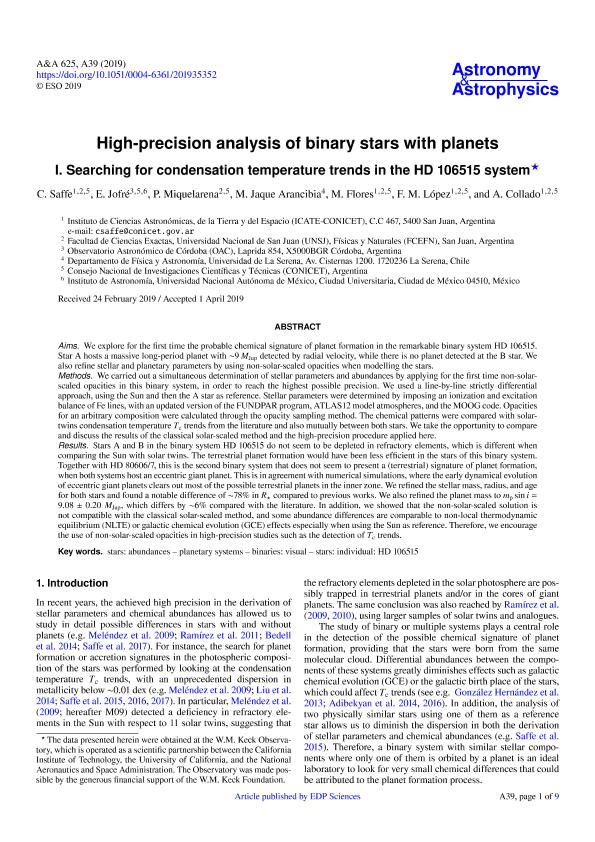Artículo
High-precision analysis of binary stars with planets. I. Searching for condensation temperature trends in the HD 106515 system
Saffe, Carlos ; Jofre, Jorge Emiliano
; Jofre, Jorge Emiliano ; Miquelarena Hollger, Paula Andrea
; Miquelarena Hollger, Paula Andrea ; Jaque Arancibia, Marcelo Daniel; Flores Trivigno, Matias Gaston
; Jaque Arancibia, Marcelo Daniel; Flores Trivigno, Matias Gaston ; López, Fernando Marcelo
; López, Fernando Marcelo ; Collado, Ana Elisa
; Collado, Ana Elisa
 ; Jofre, Jorge Emiliano
; Jofre, Jorge Emiliano ; Miquelarena Hollger, Paula Andrea
; Miquelarena Hollger, Paula Andrea ; Jaque Arancibia, Marcelo Daniel; Flores Trivigno, Matias Gaston
; Jaque Arancibia, Marcelo Daniel; Flores Trivigno, Matias Gaston ; López, Fernando Marcelo
; López, Fernando Marcelo ; Collado, Ana Elisa
; Collado, Ana Elisa
Fecha de publicación:
04/2019
Editorial:
EDP Sciences
Revista:
Astronomy and Astrophysics
ISSN:
0004-6361
Idioma:
Inglés
Tipo de recurso:
Artículo publicado
Clasificación temática:
Resumen
Aims. We explore for the first time the probable chemical signature of planet formation in the remarkable binary system HD 106515. Star A hosts a massive long-period planet with ∼9 MJup detected by radial velocity, while there is no planet detected at the B star. We also refine stellar and planetary parameters by using non-solar-scaled opacities when modelling the stars. Methods. We carried out a simultaneous determination of stellar parameters and abundances by applying for the first time non-solar-scaled opacities in this binary system, in order to reach the highest possible precision. We used a line-by-line strictly differential approach, using the Sun and then the A star as reference. Stellar parameters were determined by imposing an ionization and excitation balance of Fe lines, with an updated version of the FUNDPAR program, ATLAS12 model atmospheres, and the MOOG code. Opacities<br />for an arbitrary composition were calculated through the opacity sampling method. The chemical patterns were compared with solar-<br />twins condensation temperature Tc trends from the literature and also mutually between both stars. We take the opportunity to compare<br /><div>and discuss the results of the classical solar-scaled method and the high-precision procedure applied here. Results. Stars A and B in the binary system HD 106515 do not seem to be depleted in refractory elements, which is different when comparing the Sun with solar twins. The terrestrial planet formation would have been less efficient in the stars of this binary system. Together with HD 80606/7, this is the second binary system that does not seem to present a (terrestrial) signature of planet formation, when both systems host an eccentric giant planet. This is in agreement with numerical simulations, where the early dynamical evolution of eccentric giant planets clears out most of the possible terrestrial planets in the inner zone. We refined the stellar mass, radius, and age for both stars and found a notable difference of ∼78% in R compared to previous works. We also refined the planet mass to mp sin i = 9.08 ± 0.20 MJup, which differs by ∼6% compared with the literature. In addition, we showed that the non-solar-scaled solution is not compatible with the classical solar-scaled method, and some abundance differences are comparable to non-local thermodynamic equilibrium (NLTE) or galactic chemical evolution (GCE) effects especially when using the Sun as reference. Therefore, we encourage the use of non-solar-scaled opacities in high-precision studies such as the detection of Tc trends.</div><div><br /></div>
Archivos asociados
Licencia
Identificadores
Colecciones
Articulos(CCT - CORDOBA)
Articulos de CTRO.CIENTIFICO TECNOL.CONICET - CORDOBA
Articulos de CTRO.CIENTIFICO TECNOL.CONICET - CORDOBA
Articulos(ICATE)
Articulos de INST.D/CS ASTRONOMICAS D/LA TIERRA Y DEL ESPACIO
Articulos de INST.D/CS ASTRONOMICAS D/LA TIERRA Y DEL ESPACIO
Citación
Saffe, Carlos; Jofre, Jorge Emiliano; Miquelarena Hollger, Paula Andrea; Jaque Arancibia, Marcelo Daniel; Flores Trivigno, Matias Gaston; et al.; High-precision analysis of binary stars with planets. I. Searching for condensation temperature trends in the HD 106515 system; EDP Sciences; Astronomy and Astrophysics; 625; 4-2019; 1-9
Compartir
Altmétricas



